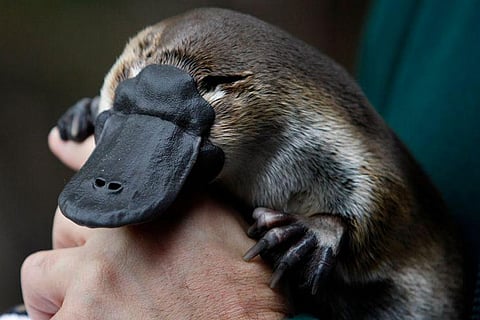

Chennai
It’s hard to blame him: What other animal has a rubbery bill, ankle spikes full of venom, luxurious fur that glows under black light and a tendency to lay eggs?
Centuries later, we’re still trying to tease the platypus apart, now with subtler tools. What we find may lead us to ask: Is the platypus normal, and are we the thing that turned out strange?
On Wednesday in Nature, researchers presented the most complete platypus genome yet assembled, along with the genome of a close relation, the short-beaked echidna. By diving into their DNA, researchers can uncover the genes and proteins that underpin some of these creatures’ distinctive traits, and better understand how mammals like us evolved to be so unlike them. The platypus and four echidna species, all native to Australia, are the world’s only living monotremes — a group perhaps best known for their unique reproductive strategy, which involves laying eggs and then nursing their young once they’ve hatched.
“They are very bizarre in many ways,” said Guojie Zhang, a genomicist at the University of Copenhagen and a leader of the sequencing effort. But because the monotremes diverged from other mammals so early — about 187 million years ago — they are also “very important for understanding mammalian evolution,” he said.
Indeed, some monotreme traits that seem so strange to us may have actually been present in the ancestor we all share. The platypus genome was first sequenced in 2008.
Since then, improvements in technology have made it much easier to map the placement of particular genes onto chromosomes.
In the earlier attempt, only about 25 percent of the platypus genome was contextualized in such a way, Dr. Zhang said, while the new version is 96 percent mapped. “It’s very complete,” he said. “We find a lot of genes that have been missed in previous assemblies.” The new genomes validate many previous findings about the platypus and, combined with the new echidna genome, “add much more clarity to the evolutionary mechanisms involved,” said Wesley Warren, a professor of genomics at the University of Missouri, who led the 2008 sequencing study but was not involved in this one. “In my opinion, among mammals, the platypus is the most fascinating species of all,” he added. “They represent the ancestral state of what terrestrial mammal genomes could have been before adapting to various environments.” Having such a comprehensive map enables comparisons among the genomes of different species, and helps fill gaps in the step-by-step story of how mammals appeared and then diverged. Many birds and insects have multiple copies of a gene called vitellogenin, involved in production of egg yolks. Most mammals don’t have the vitellogenin gene, said Dr. Zhang. But new genomes reveal that platypuses and echidnas have one copy of it, helping to explain their anomalous egg-laying — and suggesting that this gene (and perhaps the reproductive strategy itself) may have been something the rest of us lost, rather than an innovation of the monotremes.
Meanwhile, they also have milk-producing genes similar to ours and those of other mammals, allowing them to nourish their young.
Cara Giaimo is a science correspondent with NYT©2020
The New York Times
Visit news.dtnext.in to explore our interactive epaper!
Download the DT Next app for more exciting features!
Click here for iOS
Click here for Android